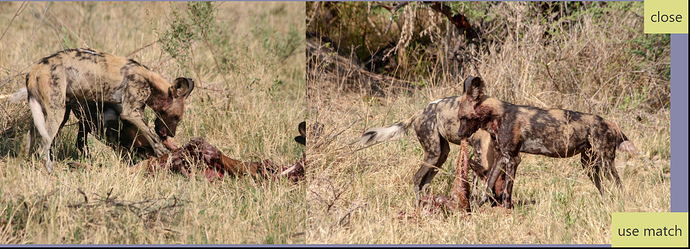What Wildbook should this feature be in? ACW
What would you like to see?
To be honest, I need to understand how Visual Matcher is supposed to work before I can say that it’s useful in ACW but one problem I noticed is that if there are multiple animals in a candidate match photo, there’s no way for me to tell which animal is being proposed as the match - see screenshot below
How would this functionality help you?
It would allow me to confirm a match or not, based on knowing which animal in the candidate pic is being proposed as the match.
If the visual matcher compared annotation to annotation, rather than mediaAsset to mediaAsset, would that address this? Or would you potentially lose valuable context by not having the entire image?
Yes, annotation to annotation would be better. Ideally, though, the candidate match images would display the same way images for an encounter record are displayed, i.e. full image with bounding box showing which animal in the picture is the candidate match. Hope that makes sense.
I understand what you’re describing. Why would it be better for it to display as MediaAssets with the bounding box, rather than as an annotation?
- Is it a matter of lost context without the full image?
- Is it because you want to see consistent displays between different parts of the product?
Yes, media asset with bounding box would be ideal. It’s for a couple of reasons:
- As previously mentioned, it’s necessary when more than 1 individual is in the candidate image.
- To see other animals present, particularly with social group species, can help the researcher ID the social group. Seeing who was with whom is valuable and we don’t want to remove that in any image displayed if we can avoid it. This has been highlighted as very important by the team at BPC.
Yes, that answers my question. The full asset is a benefit because of the additional context provided. Thanks.
I’m going to accept the request, because this is absolutely going to be addressed for Next Gen; we want to make it where a user is able to see the asset and zoom to the annotation. It seems that will address this in full.
1 Like
